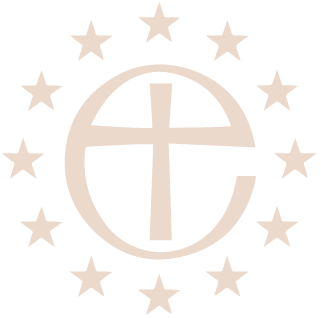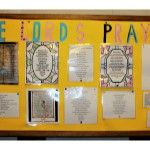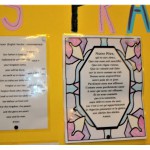Lent 3 2019 (Lent Series on the Liturgy – 3. The Sacrament of Prayer)
Sermon preached by the Revd. Canon Leonard Doolan.
Over these weeks in Lent I will be offering 5 sermons based on the Liturgy – the weekly offering of the church in which God’s glory in Christ, and in us, is celebrated. This is the third in the series.
Each week the subject will be preceded by the word ‘sacrament’. I am using this word in its loosest sense because I do not want to confuse what we are doing with the 7 formally recognized Sacraments of the church. This ‘looseness’ of the word ‘sacrament’ I discovered recently when reading a book on the Eucharist by the great Orthodox theologian, Father Alexander Schmemann.
I am working with the basic meaning of ‘sacrament’, namely ‘the outward visible sign of a hidden invisible grace’. In other words, a mystery revealed.
To recap – in the first week we thought about the nature of the church focusing on the image of the ‘household’ and then we moved to thinking about the Sacrament of the Gathering of the household of faith, and the immediate need for repentance, Kyrie Eleison, followed by the outburst of Gloria (except in Lent and Advent). In week 2 we reflected on the Sacrament of the Word, balancing the word of God in scripture, and God in Christ as the Word made flesh. This week we will consider the Sacrament of Prayer.
To help us focus, we will consider five points of prayer that occur in our Liturgy: the Trinity, the Collect, the Intercessions, the Lord’s Prayer, and the Dismissal. In case you are wondering about the Great Thanksgiving Prayer when we place before us bread and wine, I will include this in 2 weeks’ time, when we think of the Sacrament of Offering. And so to Prayer.
It goes without saying that people of faith, pray, or should pray. The truth is that many don’t, either because they have not made the connection between church-going and prayer, or because they think that prayer is too difficult. ‘Will I be able to find the right words?’ ‘What happens if I get tongue-tied?’. Best to leave the praying to the professionals who have studied theology.
This view has to be corrected – we have to be confident people of prayer, first and foremost. St. Evagrius of Pontus said, ‘If you are a theologian you will really pray, and if you really pray you are a theologian’ (de Oratione 60). So let’s all pray and become professors of theology!
There is no right or wrong language in your prayers, only the conviction that prayer is the language of God, and that when we pray we are being changed. Whatever is in your heart just pray it. God already knows, but he needs each of us to be co-workers with him.
But what about the public prayer of the church – those parts of the Liturgy when we are praying formally and together.
The first time we do this in the Liturgy may not be so transparent. We begin with the words, ‘in the name of the Father, and of the Son, and of the Holy Spirit’. We are invoking the Holy Trinity, the God of our baptismal faith, to be present as we gather together. The truth is that we cannot invoke the presence of the Holy Trinity, for the Holy Trinity is already present. Indeed there is nowhere that the Holy Trinity is not present, for God is everywhere. So when we invoke the Holy Trinity it is we who are consciously entering into that which constantly exists – we are making a statement that the Holy Trinity just ‘is’ and by saying the words we are ‘sacramentalising’ the mystery, that is, we are making it consciously present in our Gathering. The language of God is prayer, and so the life of the Divine Trinity is a life of everlasting prayer. We are baptised into the divine name of the Trinity, so we are baptised into that life of prayer. So we commence our Liturgy by naming the source and fountain of prayer.
The second ‘prayer point’ is what we call the Collect. Of course, unlike our private prayers where the beauty of the language doesn’t matter, the public prayer of the church is set down in words that reflect our corporate faith, so the language is formal. However, it is prayer, and has to be offered as such. It is not just a formula of words that we listen to as the priest reads them. When the Collect is introduced by the words, Let us pray, it is into the activity of prayer that we are invited to enter, not a world of words. So it is common now, after the words of invitation, for a few still moments to exist before the Collect begins.
It is now frequently the case that the priest prays the Collect publicly with hands open. This is a posture referred to as ‘orans’ from the Latin word for prayer. There are ancient frescoes that show Christians in prayer, with their hands ‘orans’ open in prayer. In some of the ancient churches of the East this still is the case, and of course we are accustomed to seeing Muslims praying in this way – but it is the ancient Christian posture for prayer. It is symbolic of being open to the will of God, having an open heart ready to do his will, ready to receive from God in prayer. This kneeling down, eyes tight shut, with hands held together, as we might teach our children to do, is not an ancient practice, and though some of us may still habitually pray like this, for many it is a caricature of prayer that has no great heritage.
I began our study this morning by talking about the constant prayer life of the Trinity, so you will find that all Collects follow a rather set formula. It will always be addressed to the Father (though 2 weeks ago I did mention one Collect that breaks that rule) and the content of the Collect will normally end ‘through Jesus Christ our Lord, who is alive and reigns with you, in the unity of the Holy Spirit, one God, now and forever. Amen.’ This is deeply Trinitarian. There is an option now for simpler collects to be used Sunday by Sunday, and often we use that prayer at St. Paul’s but those always end in some way by saying that the prayer is offered through Jesus Christ. This is because we believe that Jesus is the touching point in prayer between us and God – he is the great Intercessor.
The next prayer point in our Liturgy is that part we refer to officially as the Intercessions. These are a particular form of prayer. The Intercessor, who is more often than not, a member of the congregation, a baptised member of the household offering the household’s prayers, expresses in some form of words the needs and concerns of the world, the Church, the nations and community, the sick and suffering, and those who died. God knows all these things already, and he knows the heart of the person leading the intercessions. However, if God is everywhere in Trinity, and prayer is the language of Trinity which means prayer is everywhere, then prayer has to be ‘somewhere’, and in the Liturgy we create ‘somewheres’ and so we pray together. We offer the prayer to God the Father, through Jesus Christ, and in the power of the Holy Spirit. We refer to the prayer form as ‘petitions’ and in between the petitions we ask that God will hear the prayer ‘Lord in your mercy…hear our prayer’ or some such words.
Until just a few decades ago only the priest would have offered the intercessory prayer, and it was a fixed prayer, such as the Book of Common Prayer Liturgy where the prayer was offered ‘for the church militant here on earth’. Now the church rightly wishes to energise the ministry of all the baptised, so many more people now actively participate in the Liturgy. It is also sends out a powerful image of the church, and many Orthodox who worship with us take particular note of this lively participation.
When we speak of or about prayer, many will immediately think of that prayer referred to commonly as The Lord’s Prayer. It is so well known, well loved, and appeals to non-believers as well as members of the household of faith. Prayed in every language under the sun, it is the universal outward sign of the sending of the Holy Spirit at Pentecost, the overturning of the spiritual chaos created by the Tower of Babel. Our Sunday School has been working with Lynne over some weeks to gather together the Lord’s Prayer in every language which is the mother tongue of members of our congregation. It is often referred to in other traditions as the ‘Pater Noster’ (Latin), the ‘Pater Imon’ (Greek).
Jesus teaches this prayer to his disciples and his church teaches it to his followers in every generation. I like to encourage people to use their first language to pray the Lord’s Prayer, as for many the way they will pray this is an essential part of their identity and language.
The prayer addresses God as Father – Abba. It refers to his universal abode – the heavenly realm, and it honours his divine name, the name that Jews were not allowed to mention or to write, so hallowed is it. We pray for the kingdom to come among us as the perfection of God’s kingdom is – this is why it seems so appropriate to pray this with open hands, because this is how we receive something. We pray that we might be obedient to God’s will, an obedience that was shown par excellence in the life and death of the one who is teaching the prayer. We know our absolute need for God, and our hearts are restless until they find their rest in him, and so our daily bread is not just food for the belly, but the feeding of word and sacrament, and we pray that fortified by our faith in God’s name and the bread from heaven, our desire to see the kingdom established, we will lead Christ-like lives and be strengthened against the works of the Evil One. It is the whole faith, summed up in prayer, and offered in the language of all nations – the prayer meeting point of all humanity.
The last prayer point in our Liturgy is literally at the end. It is the Dismissal – Go in peace to love and service the Lord – or some form of that. This is a far better Anglican format than ‘The Mass is ended. Go in peace’. The reason is that the Mass is not ended. Mass comes from mission which gives this word Mass an apostolic urgency. When the deacon dismisses the household it is not because the Liturgy is done, but quite the opposite. Everything you have said and done; everything you have received and shared; everything that you have read and prayed, MUST now be sent out, for how else can Christ’s people be the salt and the light for the world. God’s praying people have to be God’s serving people – praying in and for the world, and serving in and for the world. So our prayer is a bit like your Athenscard. You have to validate it, and our prayer together infects and affects what we do all through the week in our life and work and individual journeys, and then we return again and again on the Lord’s day to refresh our hearts in prayer, to be renewed in the Spirit of prayer, and to be sent out again and again to live in the world in which so much prayer is needed.
So prayer tops and tails our Liturgy. Prayer is the ‘golden thread’ that weaves its way through our Liturgy, and it is prayer that holds together the fabric of our Liturgy, our work of praise. As in Liturgy, so in life.





No Comments